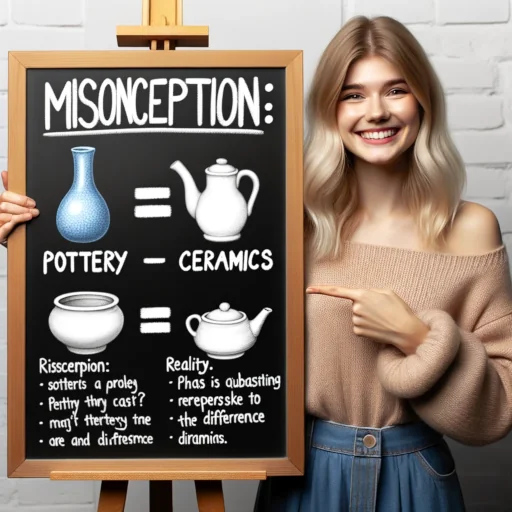It’s clear that there are several misconceptions about the terms “pottery” and “ceramics.” Here are some key points to clarify these misconceptions:
| Misconception | Reality |
|---|---|
| Pottery and Ceramics are the same | Pottery is a subset of ceramics |
| All Ceramics are made from clay | Ceramics can be made from various materials |
| Pottery is always handmade | Ceramics can be machine-made |
| Ceramics are not functional | Ceramics can be both functional and artistic |
| Pottery is not durable | Durability depends on the type of clay and firing process |
| The production process is the same | Different methods and materials are used |
| Ceramics are modern, Pottery is traditional | Both have ancient origins and have evolved |

1. Pottery and Ceramics are the Same Thing
Misconception: Many people think pottery and ceramics are interchangeable terms.
Reality: Pottery is a subset of ceramics. Ceramics is a broader term that includes pottery but also encompasses other items made from non-metallic and inorganic materials like bricks and cement. Pottery is specifically made from clay and is usually functional, like bowls or mugs.
2. All Ceramics are Made from Clay
Misconception: The belief that ceramics are solely made from clay.
Reality: While pottery is exclusively made from clay, ceramics can be made from a variety of materials, including silica and glazes. These materials are also subjected to high temperatures to become ceramics.
3. Pottery is Always Handmade
Misconception: The idea that pottery is always handmade, giving it a rustic and traditional feel.
Reality: While it’s true that pottery often has a handmade quality, ceramics can be machine-made and are often used in industrial settings for precision engineering.
4. Ceramics are Not Functional
Misconception: Ceramics are often considered to be more artistic and less functional than pottery.
Reality: Ceramics can be both functional and artistic. They are used in a wide range of applications, from kitchenware to car engines and even armor.
5. Pottery is Not Durable
Misconception: Pottery is often considered less durable than ceramics.
Reality: The durability of pottery depends on the type of clay used and the firing process. Stoneware and porcelain, for example, are types of pottery that are quite durable.
6. The Production Process is the Same
Misconception: The production process for pottery and ceramics is the same.
Reality: Pottery is usually made by hand or on a potter’s wheel and involves a more linear and traditional process. Ceramics, on the other hand, can involve different methods of firing and can be made from different elements.
7. Ceramics are Modern, Pottery is Traditional
Misconception: Ceramics are a modern invention, while pottery is traditional.
Reality: Both have ancient origins but have evolved over time. Modern ceramics are used in various technological applications, while pottery techniques have also seen innovations but have largely remained traditional.
Deeper Dive: How do common misconceptions about “pottery” and “ceramics” influence public perception and engagement with these mediums, and what might be the broader implications for the fields of art, craft, and material science?
I’m sure you will agree the topic of common misconceptions between pottery and ceramics raises intriguing issues about understanding and categorizing these forms of art and craft.
My question invites exploration into how misunderstandings about terminology can shape cultural attitudes, market valuations, and even educational approaches, thereby affecting both artists and audiences in the realms of pottery and ceramics.
Common misconceptions about “pottery” and “ceramics” can have a far-reaching impact on public perception, engagement, and even the development of these fields. Here’s how I break it down:
Influence on Public Perception and Engagement
- Accessibility: Misconceptions like “pottery is always handmade” might lead people to view pottery as more accessible, while “ceramics are modern” could make ceramics seem more elite or specialized, influencing who engages with each medium.
- Value and Appreciation: If people believe that “pottery is not durable,” they might be less willing to invest in or appreciate pottery pieces. On the other hand, if “ceramics are not functional,” it could limit the market to only those interested in decorative art.
- Cultural and Historical Understanding: Misconceptions like “ceramics are modern, pottery is traditional” can distort our understanding of the historical and cultural roles these crafts have played.
Implications for Art and Craft
- Market Dynamics: Misconceptions can affect the commercial aspects, including pricing and demand. For instance, the false idea that all ceramics are not functional might limit their market to art collectors, while pottery might be relegated to a more ‘craftsy,’ lower-value market.
- Educational Programs: Misconceptions could influence what is taught in educational settings. For example, if ceramics are seen as more ‘scientific,’ courses might focus more on material science aspects, potentially neglecting the craft and artistic elements.
- Identity and Recognition: Artists may choose or avoid labels based on public perception, which could have implications for how their work is recognized and categorized.
Implications for Material Science
- Research Focus: If ceramics are wrongly thought to be exclusively modern and high-tech, this could influence funding and research focus, possibly at the expense of more ‘traditional’ techniques that also have valuable applications.
- Cross-Pollination: The misconception that “the production process is the same” could limit interdisciplinary research and the sharing of techniques between the crafts and material sciences.
- Public Funding: Misconceptions about the utility and function of ceramics and pottery could impact public funding for research, with potentially more ‘practical’ or ‘modern’ projects receiving better funding.
As you can see, misconceptions about “pottery” and “ceramics” can have a ripple effect, influencing everything from individual engagement and market dynamics to educational focus and research funding. Correcting these misconceptions is not just a matter of semantic accuracy but can have real-world implications for artists, craftsmen, and scientists alike.





